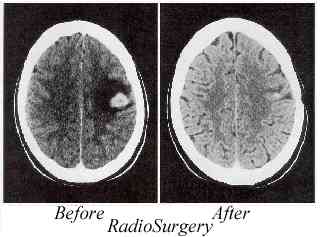Int J Radiat Oncol Biol Phys 1996 Apr 1;35(1):27-35
A
multiinstitutional outcome and prognostic factor analysis of radiosurgery for resectable
single brain metastasis.
Auchter RM, Lamond JP, Alexander E, Buatti JM, Chappell R, Friedman WA, Kinsella TJ,
Levin AB, Noyes WR, Schultz CJ, Loeffler JS, Mehta MP
Department of Human Oncology, University of Wisconsin-Madison, USA.
The RS databases of four institutions were reviewed to identify patients who met the
following criteria: single-brain metastasis; no prior cranial surgery or WBRT; age > 18
years; surgically resectable lesion; Karnofsky Performance Status (KPS) > or = 70 at
time of RS; nonradiosensitive histology. One hundred twenty-two patients were identified
who met these criteria. RS was performed with a linear accelerator based technique
(peripheral dose range was 10-27 Gy, median was 17 Gy). WBRT was performed in all but five
patients who refused WBRT (dose range was 25-40 Gy, median was 37.5 Gy). RESULTS: The
median follow-up for all patients was 123 weeks. The overall local
control rate (defined as lack of progression in the RS volume) was 86%.
Intracranial recurrence outside of the RS volume was seen in 27 patients (22%). The actuarial median survival from date of RS is 56 weeks, and the 1-year
and 2-year actuarial survival rates are 53% and 30%. The median duration of functional
independence (sustained KPS > or = 70) is 44 weeks. Nineteen of 77 deaths
were attributed to CNS progression (25% of all deaths). CONCLUSION: The RS in
conjunction with WBRT for single brain metastasis can produce substantial functional
survival, especially in patients with good performance status and without extracranial
metastasis. These results are comparable to recent randomized
trials of resection and WBRT. The advantages of RS over surgery in terms of
cost, hospitalization, morbidity, and wider applicability strongly suggest that a
randomized trial to compare RS with surgery is warranted.
J Neurosurg 1996 May;84(5):748-54
Surgery versus radiosurgery in the treatment of brain metastasis.
Bindal AK, Bindal RK, Hess KR, Shiu A, Hassenbusch SJ, Shi WM, Sawaya R
Department of Neurosurgery, University of Texas M. D. Anderson Cancer Center, Houston,
USA.
Surgery and radiosurgery are effective treatment modalities for brain metastasis. To
compare the results of these treatment modalities, the authors followed 13 patients
treated by radiosurgery and 62 patients treated by surgery who were retrospectively
matched. Patients were matched according to the following criteria: histological
characteristics of the primary tumor, extent of systemic disease, preoperative Karnofsky
Performance Scale score, time to brain metastasis, number of brain metastases, and patient
age and sex. For patients treated by radiosurgery, the median size of the treated lesion
was 1.96 cm3 (range 0.41-8.25 cm3) and the median dose was 20 Gy (range 12-22 Gy). The median survival was 7.5 months for patients treated by radiosurgery
and 16.4 months for those treated by surgery; this difference was found to be
statistically significant using both univariate (p = 0.0018) and multivariate (p = 0.0009)
analyses. The difference in survival was due to a higher rate of mortality from brain
metastasis in the radiosurgery group than in the surgery group (p < 0.0001) and not due
to a difference in the rate of death from systemic disease (p = 0.28). Log-rank analysis
showed that the higher mortality rate found in the radiosurgery group was due to a greater
progression rate of the radiosurgically treated lesions (p = 0.0001) and not due to the
development of new brain metastasis (p = 0.75).On the basis of their data, the authors
conclude that surgery is superior to radiosurgery in the treatment of brain metastasis.
Patients who undergo surgical treatment survive longer and have a better local control. The data lead the authors to suggest that the indications for
radiosurgery should be limited to surgically inaccessible metastatic tumors or patients in
poor medical condition. Surgery should remain the treatment of choice whenever possible.
Defining the role of stereotactic radiosurgery versus
microsurgery in the treatment of single brain metastases.
Schoggl A, Kitz K, Reddy M, Wolfsberger S, Schneider B, Dieckmann K, Ungersbock K.
Department of Neurosurgery, University of Vienna, Austria. Acta Neurochir
(Wien). 2000;142(6):621-6.
Stereotactic radiosurgery (RS) and surgery have proved to be effective treatment
modalities for brain metastasis. We followed 133 patients whose treatment for intracranial
disease was either RS or a single surgical resection at the University of Vienna from
August 1992 through October 1996. All patients who received additional Whole Brain
Radiotherapy were included. This was a retrospective, case-control study comparing these
treatment modalities. Sixty-seven patients were treated by RS and 66 patients were treated
by microsurgery. The median size of the treated lesions for RS patients was 7800 mm3, and
12500 mm3 for microsurgery patients, respectively. The median dose delivered to the tumour
margin for RS patients was 17 gray. The median survival for patients after RS was 12
months, and 9 months for patients after microsurgery. This difference was not
statistically significant (p = 0.19). Comparison of local tumour control, defined as
absence of regrowth of a treated lesion, showed that tumours
following RS had a preferred local control rate (p < 0.05). Univariate and
multivariate analysis showed that this fact was due to a greater response rate of
"radioresistant" metastasis to RS (p < 0.005). Postradiosurgical
complications included the onset of peritumoural oedema (n = 5) and radiation necrosis (n
= 1). Two patients after microsurgery experienced local wound infection. One postoperative
death occurred due to pulmonary embolism in this group. On the
basis of our data we conclude that RS and microsurgery combined with Whole Brain
Radiotherapy are comparable modalities in treating single brain metastasis. Concerning
morbidity and local tumour control, in particular in cases of "radioresistant"
primary tumours, RS is superior. Therefore we advocate RS except for cases of large
tumours (> 3 cm in maximum diameter) and for those with mass effect.
|
